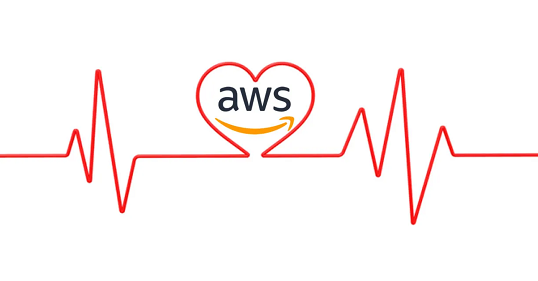Everyone in U.S. healthcare - providers, insurers, pharma, and tech companies - is busy modernizing their ancient systems. Thanks to grown-up technologies like cloud, AI, and microservices, healthcare is getting the investment it needs to cut the bureaucracy. That means less clicking for doctors and better digital experiences for patients. But of course, nothing good comes without pain-cybersecurity risks, legacy systems that don’t want to die, and the ever-present chaos of human error are still in the mix. However, these things are manageable.
Sectors Driving Modernization in 2025
Healthcare Providers (Hospitals & Health Systems)
Modernization backlog in the U.S. hospitals has been growing for more than a decade under the weight of legacy EHRs, disconnected workflows, and documentation systems that force clinicians to copy-paste.
Most hospitals replace core infrastructure before building anything new. That means EHR migrations, ERP consolidations, and cloud-hosted backend upgrades to scale across facilities. The Veterans Health Administration is the most public example - now deploying Oracle Health across 13 new sites with the goal of creating a unified record that spans different departments. Similar moves play out quietly inside regional systems that have been running unsupported software since the Obama era.
Clinician-facing modernization, however, is where momentum is most welcome. At Ohio State’s Wexner Medical Center, 100 physicians piloted Microsoft’s DAX Copilot and gained back 64 hours from documentation duties. That’s literal time restored to patient care, without hiring anyone new. And it’s exactly the kind of small-scope, high-impact win that other systems are now copying. Children’s National Hospital is going broader, experimenting with generative AI to reshape how providers interact with clinical data by reducing search.
Modernization used to mean cost. Now it means capacity. Digital tools are being deployed where FTEs are short, where burnout spike, and where attrition has already created blind spots in workflows. And that’s why boards are green lighting infrastructure projects that would have been stuck in committee five years ago.
The barrier, in most cases, is coherence. Hospitals know they need to modernize, but don’t always know where to start or how to sequence. Teams want automation, but they’re still duct-taping reports together from five systems that don’t talk. That’s where most providers are stuck in 2025: trapped between urgency and fragmentation.
The systems that are breaking through are mapping out modernization in terms of what actually improves the patient and staff experience: real-time BI dashboards instead of retrospective reports, mobile-first scheduling tools that sync with HR systems, ambient listening that captures the record without forcing clinicians to become transcriptionists.
Belitsoft’s healthcare software experts modernize legacy systems, simplify processes, and implement clinician-facing tools that reduce friction in care delivery. We help providers align modernization with clinical priorities, supporting everything from building custom EHR systems to healthcare BI and ambient documentation.
Health Insurance Payers (Health Plans)
In 2025, health plans replace brittle adjudication systems with cloud-native core platforms built around modular, API-first design.
They pursue more narrow networks, value-based care contracts, and hybrid offerings like telehealth-plus-pharmacy bundles. Legacy systems were never designed to track those parameters, let alone price them dynamically or support real-time provider feedback loops.
That’s why firms like HealthEdge and their integration partners are getting traction — for enabling automation, and for embedding claims payment integrity and fraud detection directly into the workflow. In 2025, that’s the move: shift from audit-and-chase to real-time correction. Not post-event fraud analytics - preemptive denial logic, powered by AI.
Member experience modernization is the other front. Health plans can’t afford to lose members over clunky app experiences, slow pre-auth workflows, or incomplete provider directories.
Payers are investing in:
- API-integrated portals that allow self-service claims and virtual ID cards
- Telehealth services, especially for behavioral health, built into benefit design
- Real-time benefits lookups, connected directly to provider systems
- Omnichannel engagement platforms that consolidate outreach, alerts, and support
They’re expectations. And insurers that delay will watch their NPS scores erode — along with their employer group contracts.
Regulatory pressure is also reshaping the agenda. Payer executives now list security and compliance as top risks in any tech upgrade. Only a third of them feel confident they’re ready for incoming regulatory changes
That means modernization isn’t just a technology lift. New systems are being evaluated based on:
- Audit-readiness
- Data governance visibility
- API traceability
- Identity and access control fidelity
- Integration with CMS-mandated interoperability endpoints
Pharmaceutical & Life Sciences Companies
In 2025 most large life sciences companies have finally accepted what startups realized years ago: you can’t do AI-powered anything on top of fragmented clinical systems.
Top-20 pharma companies are actively overhauling their clinical development infrastructure - migrating off the siloed, custom-coded platforms that once made sense in a regional, paper-heavy world, but now slow everything from trial design to regulatory submissions. According to McKinsey, nearly half of big pharma has invested heavily in modernizing their clinical development stack. That number is still growing.
The pain points driving this shift are familiar: trial startup timelines that drag on for quarters, data systems that can’t integrate real-world evidence, and analytics teams forced to export CSVs just to compare outcomes across geographies. That’s a strategic bottleneck.
Modernized platforms are solving it. Companies that have replaced legacy CTMS and EDC tools with integrated cloud systems are reporting 15–20% faster site selection and up to 30% shorter trial durations - just from clean workflow automation and real-time visibility across sites.
Modernizing clinical trial systems opens the door to better ways of running studies. Adjusting them as they go, letting people join from anywhere, predicting how trials will play out, or using AI to design the trial plan. All of that sounds like the future, but none of it works on legacy platforms. The AI can’t model if your data is spread across four systems, six countries, and seventeen formats.
That’s why companies like Novartis, Pfizer, and AstraZeneca are rebuilding their infrastructure to make that possible. Faster trials mean faster approvals. Faster approvals mean more exclusive runway. Every month saved can mean tens of millions in added revenue.
McKinsey notes that 30% of top pharma players have only modernized one or two applications - usually as isolated pilots. These companies are discovering that point solutions don’t scale unless the underlying platform does. It’s not enough to deploy an AI model or launch a digital trial portal. Without a harmonized application layer beneath it, the benefits stall. You can automate one process, but you can’t orchestrate the whole trial.
Outside of R&D, the same dynamic is playing out in manufacturing and commercial. Under the Pharma 4.0 banner, companies are digitizing batch execution, tracking cold-chain logistics in real time, and using analytics to reduce waste - not just to report it. On the commercial side, modern CRMs help sales teams target the right providers with better segmentation, and integrated data platforms are feeding real-time feedback loops into brand teams. But again, none of that matters if the underlying systems can’t talk to each other.
Health Tech Companies and Vendors
The biggest EHR vendors are no longer just selling systems of record. They’re rebuilding themselves as data platforms with embedded intelligence. Oracle Health (formerly Cerner) is shipping a cloud-native EHR built on its own OCI platform, with analytics and AI tools hardwired into the experience. This is a complete rethinking of how health data flows across settings - including clinical, claims, SDoH, and pharmacy - and how clinicians interact with it. Oracle’s voice-enabled assistant is the new UI.
Epic is taking a similar turn. By early 2025, its GPT-powered message drafting tool was already generating over 1 million drafts per month for more than 150 health systems. Two-thirds of its customers have used at least one generative feature. They’re high-volume use cases that clinicians now expect in their daily workflows. What used to be “will this work?” is now “why doesn’t our system do that?”
Vendor modernization is now directly reshaping clinician behavior, admin efficiency, and patient experience - whether you’re ready or not.
On the startup side, digital health funding has rebounded - with $3B raised in Q1 2025 alone. Startups are leapfrogging legacy tools with focused apps:
- Virtual mental health that delivers within hours
- Remote monitoring platforms that plug directly into EHRs
- AI tools that triage diagnostic images before radiologists ever see them
Key Technologies and Approaches in 2025 Modernization
Cloud Migration
On-premises infrastructure can’t keep up with the bandwidth, compute, or integration demands of modern healthcare. Providers are now asking “how many of our systems can we afford not to migrate?”
Cloud lets healthcare organizations unify siloed data - clinical, claims, imaging, wearables - into a single stack. It enables shared analytics. It allows for disaster recovery, real-time scaling, and AI deployment. It’s also the only path forward for regulatory agility. As interoperability rules change, cloud platforms can update fast.
Microservices and Containerization
Legacy platforms are so big that if one module needs a patch, the whole stack often has to be touched. Nobody can afford this in 2025 - especially when the systems are built around scheduling, billing, or inpatient documentation. That's why organizations break apart monoliths.
Microservices and containers (via Docker, Kubernetes, and similar platforms) let IT teams refactor old systems one piece at a time - or build new services without waiting for an enterprise release cycle.
It’s how CHG Healthcare built a platform to deploy dozens of internal apps in containers - standardizing workflows and cutting deployment times dramatically. It’s how hospitals are now plugging in standalone scheduling tools or analytics layers next to their EHR.
EHR Modernization
EHRs are still the spine of provider operations. For a decade, usability and interoperability were the two top complaints from clinicians and CIOs alike. In 2025, EHR vendors deliver fixes.
Epic now supports conversational interfaces, automated charting, and GPT-powered patient message replies. Oracle’s cloud EHR is designed with built-in AI assistants and analytics from the start. Meditech’s Expanse is delivering mobile-native UX and modern cloud hosting.
These are new baselines. And they’re being adopted because:
- Clinicians need workflows that reduce clicks
- Health systems need interoperability without middleware hacks
- Regulators are demanding FHIR APIs and real-time data sharing
When the VA replaces VistA with Oracle across its entire footprint, it’s a national signal: modern EHRs are not just record systems now.
Low-Code
The staffing shortage in healthcare tech is real. And waiting months for a development team to deliver a small app is no longer acceptable. That’s why low-code platforms (Salesforce, PowerApps, ServiceNow) are gaining ground in hospital IT.
Low-code enables clinical and operational teams to launch small, high-impact tools on their own.
Examples in the field:
- A bedside tablet app that pulls data via FHIR API, built in weeks - not quarters
- Custom staff scheduling flows tied to the HR system, updated on the fly
- Patient outreach tools that route data back into the CRM without custom middleware
Artificial Intelligence and Machine Learning Integration
From clinical documentation to insurance claims to pharmaceutical R&D, AI has moved from pilot status to production use - and it’s quietly reshaping cost structures and workflows.
Clinical AI
The most visible adoption is inside hospitals and physician groups, where AI-powered scribes now operate as real-time note-takers. These ambient tools transcribe conversations and structure them into the clinical record as a usable encounter note. Early deployments are showing tangible gains: fewer hours spent documenting, faster throughput, and happier physicians.
Patient-facing apps now routinely include AI chatbots for triage, appointment scheduling, and FAQ handling, offloading low-complexity interactions that would otherwise clog up call centers or front desks.
Operational AI: Driving Down Admin Overhead in Payers and Providers
Insurers have leaned hard into AI for process-heavy work: claims adjudication, fraud detection, and summarization of policies and clinical guidelines. Automating portions of the revenue cycle has reduced manual review, improved coding accuracy, and accelerated payment timelines.
Deloitte’s 2025 survey confirms that AI is now a strategic priority for over half of payer executives, and not just for cost reduction. Underwriting, prior authentication decisioning, and customer service bots are now all AI-enabled domains - because manual handling simply doesn’t scale.
Provider systems are adopting similar logic. AI-driven tools now assist billing teams with denial management and code validation - helping recover missed revenue and reduce rejected claims, often without increasing staffing.
Pharma AI
In pharma, algorithms screen compounds, predict trial success based on patient stratification, and optimize site selection based on population health patterns. One major biopharma firm uses machine learning to model which trial protocols are most likely to succeed - and which recruitment strategies have the highest yield.
McKinsey estimates $50 billion in annual value is on the table if AI is fully leveraged across R&D. And the only thing blocking that is the systems. That’s why the smartest companies are modernizing trial management platforms, integrating real-world data, and building AI into their analytics infrastructure.
Governance Is Now Mandatory Because AI is Embedded
Once AI starts generating visit summaries, triaging patients, or flagging claims for denial - the risk of error becomes systemic.
Most provider organizations deploying clinical AI tools now have AI governance committees reviewing:
- Model accuracy and performance
- Bias and equity audits
Regulatory alignment with FDA’s evolving AI guidance
Interoperability
Interoperability is the hidden engine powering everything that matters in healthcare modernization. If your systems can’t share data through APIs, then every other investment you make will eventually stall. AI, analytics, virtual care, population health management -none of it works without integration.
The 21st Century Cures Act mandated that EHRs expose patient data through standardized FHIR APIs as a legal requirement. That mandate hit everyone who integrates with patient data: providers, payers, labs, and app developers.
Cloud integration platforms, HL7/FHIR toolkits, and master patient indexes are now readily available and built-in to most modern systems.
Modern EHRs are now deployed with real APIs. Health plans open claims data to other payers. Patients expect apps to access their records with one click. And regulators expect interoperability to be a default.
Modern health apps - whether built in-house or purchased - are expected to offer FHIR APIs, user-level OAuth security, and plug-and-play integration with at least half a dozen external systems. If they can’t? They’re not even considered in procurement.
Challenges and Barriers to Modernization in 2025
Cybersecurity
2023 and 2024 were record-setting years for healthcare data breaches, and ransomware is still a daily risk. The challenge is modernizing with zero-trust architectures, embedded encryption, real-time monitoring. Security-first modernization is slower.
Legacy Systems
Modernizing one system often means breaking five others. So teams modernize in slices. They update scheduling without touching the billing core. They roll out new patient apps while the back-end is still on-prem. And that piecemeal approach - while pragmatic - creates technical debt.
The challenge is the dependencies. It’s the billing logic no one can rewrite. The custom reporting your compliance team depends on. The integrations held together with scripts from 2011.
In 2025, the health systems making real progress are doing three things differently:
- Mapping dependencies before they pull the cord
- Using modular wrappers and APIs to isolate change
- Sequencing modernization around business impact - not tech idealism
Regulatory Requirements
Every platform you touch has to stay compliant with HIPAA, ONC, CMS, and increasingly, FDA guidance - especially if you’re embedding AI.
Replace your EHR? Make sure it’s still ONC-certified. Launch a new patient engagement app? Don’t forget consent management and audit trail requirements. Build a clinical decision tool with GPT? You may be walking into a software-as-a-medical-device (SaMD) zone.
Many payers are holding off on major IT overhauls. The risk of investing in the wrong architecture - or too early - is real.
But waiting also costs. The CEOs who are moving forward are doing so by baking compliance into the project timeline. They involve legal and clinical governance from day one. And they’re designing for flexibility because the policy won’t stop shifting.
And above all: they’re resisting the urge to rip and replace without a migration path that keeps operations intact.
Cultural Resistance
You can buy platforms but not adoption. Every new system - no matter how well designed - shows up as another thing to learn.
Innovation fatigue goes away when teams believe the new tools actually give them time back, reduce clicks, and make their lives easier.
In 2025, the organizations breaking through cultural resistance are doing two things well:
- Involving clinicians early - in co-design
- Delivering early wins - like AI scribes that give doctors back 15 minutes per visit, not promises of better care someday
- They also hire tech-savvy “physician champions,” embed superusers in departments, and give staff the support and agency to adopt at their pace.
Because if modernization is delivered as a top-down mandate? It will stall. No matter how good the system is.
Interoperability and Data Silos: Progress with Pain
Ironically, modernization projects often make interoperability harder before they make it better. That’s because new systems speak modern languages — but your data is still in the old ones.
Migrating patient records. Reconciling code sets. Building crosswalks between legacy EHRs and new cloud platforms. It all takes time.
Even when the target system is FHIR-native, the data coming in isn’t. And until all entities in your network modernize in sync, you’re living in a hybrid world - with clinical, claims, and patient-generated data split across modern APIs and legacy exports.
This isn’t a short-term challenge. It’s the operating condition of modernization in 2025. The solution is to design for coexistence. Build middleware. Accept data friction. And keep moving.
ROI Pressure
Modernization costs money. Licenses, subscriptions, cloud costs, consultants — the sticker price is high. And even if you believe in the strategy, your CFO wants proof.
That’s why the smartest CEOs are phasing modernization into value-based tranches:
- Replace the billing system after the front-end is streamlined
- Layer AI into existing documentation tools before replacing the EHR
- Roll out low-code apps to hit immediate ops gaps while core platforms evolve
And they’re tying every dollar to metrics that matter: reduced call center volumes, faster claim approvals, shortened length of stay.
Because in 2025, you need to modernize the things that move the business.
How Belitsoft Can Help
Belitsoft helps healthcare organizations modernize legacy systems with modular upgrades, smart integrations, and cloud-native tools that match the pace of clinical and business needs. Whether it’s rebuilding trial platforms, fixing disconnected EHRs, or making patient apps usable again, Belitsoft turns modernization from a bottleneck into a competitive advantage.
For Providers (Hospitals & Health Systems)
Belitsoft can support modernization efforts through:
- Custom EHR migration support: migrating from legacy systems or outdated on-premises EHRs to modern, cloud-native platforms.
- Frontend modernization: building mobile-native apps, ambient voice tools, or clinician-facing interfaces that reduce clicks and documentation overload.
- Integration layers: connecting fragmented billing, lab, and scheduling systems via FHIR APIs and custom middleware.
- Low-code tools: creating lightweight apps for patient check-in, nurse scheduling, or discharge planning without waiting for full-stack releases.
- Microservices architecture: decoupling legacy hospital software to enable modular upgrades - scheduling, reporting, documentation, etc.
Belitsoft can act as both a modernization contractor and strategic tech partner for health systems stuck between urgency and fragmentation.
For Health Plans (Payers)
Belitsoft can deliver:
- Custom modernization of adjudication and payment systems, designed with modular APIs and cloud-native infrastructure.
- Member experience modernization: building digital self-service portals, real-time benefits lookup, and omnichannel messaging tools.
- Interoperability solutions: developing APIs for CMS mandates, FHIR integration, identity management, and secure audit-ready logs.
- AI-powered automation: embedding fraud detection, denial logic, or claim prioritization into claims processing.
- Compliance-focused upgrades: modern systems built for traceability, audit-readiness, and evolving ONC/CMS requirements.
Belitsoft’s strength lies in building solutions that integrate legacy claims engines with new digital layers - enabling real-time interaction, transparency, and regulatory resilience.
For Pharma and Life Sciences
Belitsoft can offer:
- CTMS and EDC modernization: replacing siloed legacy systems with cloud-native platforms for trial design, patient recruitment, and data capture.
Analytics and BI dashboards: real-time visibility into site performance, recruitment status, and trial outcomes. - Integration of real-world evidence (RWE) into trial and commercial data pipelines.
- Manufacturing and supply chain visibility tools: real-time batch tracking, cold-chain monitoring, yield optimization.
- CRM modernization for sales teams: segmentation, real-time performance tracking, and better targeting tools.
Belitsoft can serve as a modernization partner for pharma companies looking to move beyond pilots and point solutions toward scalable digital infrastructure.
For HealthTech Vendors & Startups
Belitsoft can support healthtech vendors with:
- Cloud-native platform development: building core SaaS tools for remote monitoring, virtual care, and diagnostics.
- Modern EHR integrations: FHIR API development, SDoH data handling, and embedded analytics.
- Product-grade AI/ML integration: powering triage tools, image screening, or care recommendations with custom models and audit-ready pipelines.
- Governance tooling: dashboards for model performance, bias monitoring, and regulatory alignment.
- Interoperability-first design: plug-and-play modules that are procurement-ready (FHIR, OAuth2, audit logs).
Belitsoft can function as a full-cycle tech partner for healthtech companies - from prototype to compliance-ready production systems.
Rate this article
Recommended posts
Portfolio


Our Clients' Feedback


















.jpg)
.jpg)
.jpg)
.jpg)
.jpg)
.jpg)
.jpg)
.jpg)
.jpg)

















We have been working for over 10 years and they have become our long-term technology partner. Any software development, programming, or design needs we have had, Belitsoft company has always been able to handle this for us.
Founder from ZensAI (Microsoft)/ formerly Elearningforce